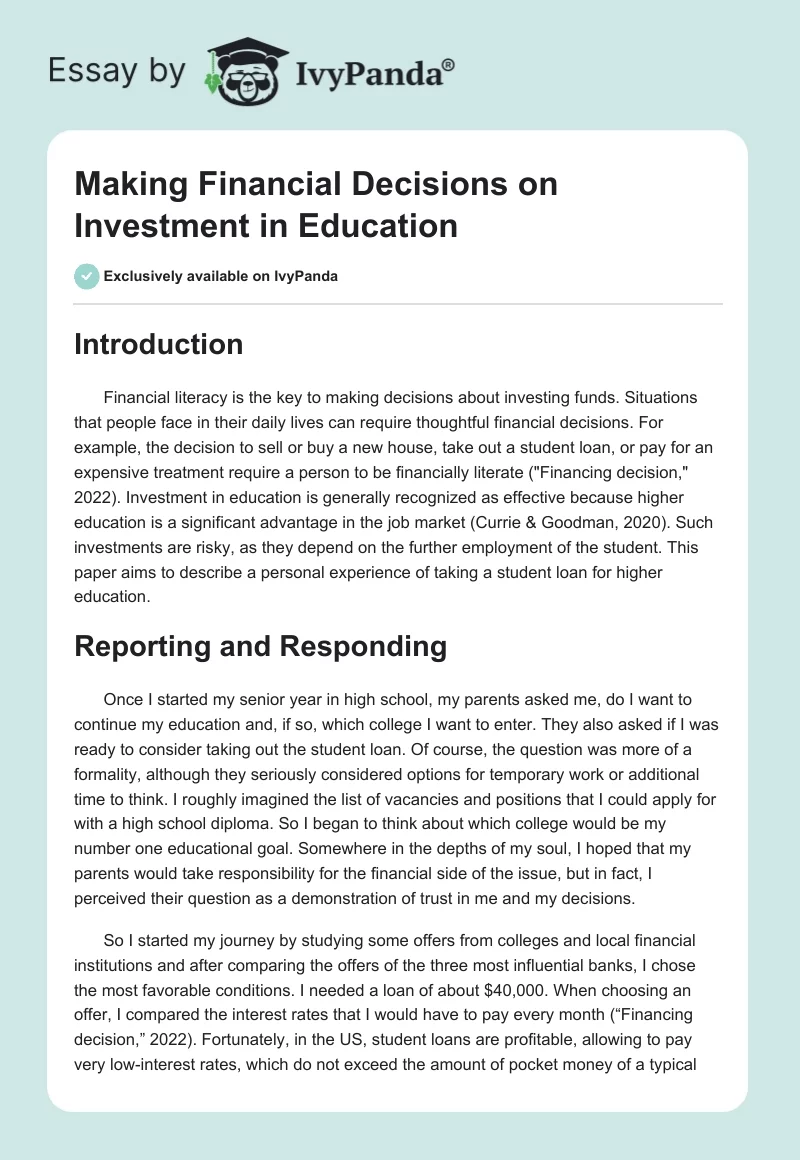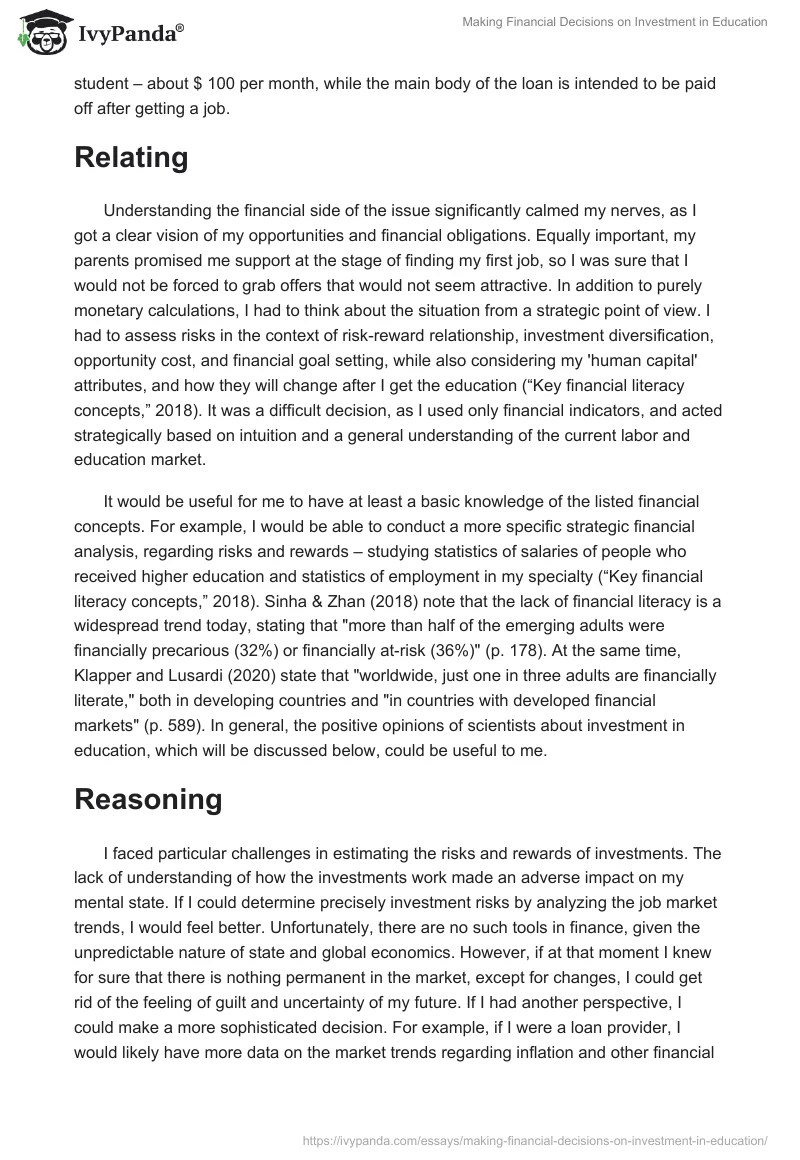Introduction
Financial literacy is the key to making decisions about investing funds. Situations that people face in their daily lives can require thoughtful financial decisions. For example, the decision to sell or buy a new house, take out a student loan, or pay for an expensive treatment require a person to be financially literate (“Financing decision,” 2022). Investment in education is generally recognized as effective because higher education is a significant advantage in the job market (Currie & Goodman, 2020). Such investments are risky, as they depend on the further employment of the student. This paper aims to describe a personal experience of taking a student loan for higher education.
Reporting and Responding
Once I started my senior year in high school, my parents asked me, do I want to continue my education and, if so, which college I want to enter. They also asked if I was ready to consider taking out the student loan. Of course, the question was more of a formality, although they seriously considered options for temporary work or additional time to think. I roughly imagined the list of vacancies and positions that I could apply for with a high school diploma. So I began to think about which college would be my number one educational goal. Somewhere in the depths of my soul, I hoped that my parents would take responsibility for the financial side of the issue, but in fact, I perceived their question as a demonstration of trust in me and my decisions.
So I started my journey by studying some offers from colleges and local financial institutions and after comparing the offers of the three most influential banks, I chose the most favorable conditions. I needed a loan of about $40,000. When choosing an offer, I compared the interest rates that I would have to pay every month (“Financing decision,” 2022). Fortunately, in the US, student loans are profitable, allowing to pay very low-interest rates, which do not exceed the amount of pocket money of a typical student – about $ 100 per month, while the main body of the loan is intended to be paid off after getting a job.
Relating
Understanding the financial side of the issue significantly calmed my nerves, as I got a clear vision of my opportunities and financial obligations. Equally important, my parents promised me support at the stage of finding my first job, so I was sure that I would not be forced to grab offers that would not seem attractive. In addition to purely monetary calculations, I had to think about the situation from a strategic point of view. I had to assess risks in the context of risk-reward relationship, investment diversification, opportunity cost, and financial goal setting, while also considering my ‘human capital’ attributes, and how they will change after I get the education (“Key financial literacy concepts,” 2018). It was a difficult decision, as I used only financial indicators, and acted strategically based on intuition and a general understanding of the current labor and education market.
It would be useful for me to have at least a basic knowledge of the listed financial concepts. For example, I would be able to conduct a more specific strategic financial analysis, regarding risks and rewards – studying statistics of salaries of people who received higher education and statistics of employment in my specialty (“Key financial literacy concepts,” 2018). Sinha & Zhan (2018) note that the lack of financial literacy is a widespread trend today, stating that “more than half of the emerging adults were financially precarious (32%) or financially at-risk (36%)” (p. 178). At the same time, Klapper and Lusardi (2020) state that “worldwide, just one in three adults are financially literate,” both in developing countries and “in countries with developed financial markets” (p. 589). In general, the positive opinions of scientists about investment in education, which will be discussed below, could be useful to me.
Reasoning
I faced particular challenges in estimating the risks and rewards of investments. The lack of understanding of how the investments work made an adverse impact on my mental state. If I could determine precisely investment risks by analyzing the job market trends, I would feel better. Unfortunately, there are no such tools in finance, given the unpredictable nature of state and global economics. However, if at that moment I knew for sure that there is nothing permanent in the market, except for changes, I could get rid of the feeling of guilt and uncertainty of my future. If I had another perspective, I could make a more sophisticated decision. For example, if I were a loan provider, I would likely have more data on the market trends regarding inflation and other financial threats (“Key financial literacy concepts,” 2018). If I were the board member of an educational institution, I could as well have more data on the market trends in specific professions.
I could play it safe and choose one of the professions that never lose the demand on the job market. Still, I wanted to follow my dream and took a risk to pursue my goals. Interestingly, Currie and Goodman (2020) say that “investments in education pay off in the form of higher future earnings, and differences in educational attainments explain a significant fraction of the adult variation in wages” (p. 239). Psacharopoulos and Patrinos (2018) add that “the private average global return to a year of schooling is 9% a year,” while social returns to schooling reach 10% (p. 445). These statistics argue for taking the risk and prove that any education is better than the absence of one.
Reconstructing
By going through this experience, I learned that financial tools can be useful in decreasing anxiety regarding financial and investment decisions. I also discovered that the future is unpredictable and one can only increase the level of certainty, but never reach 100% of it. I discovered that making personal financial decisions is not only risky and challenging but also brings pleasure through the feeling of control over my life. In future, I will try to make more sophisticated decisions, although I did not make significant mistakes with the initial one. I will probably try to get some prognostic information on economic and market trends from the stakeholders who may have such information. No less important, if I apply the newly obtained knowledge, I will make more detailed decisions in the future and will feel more confident about them.
Conclusion
Thus, a personal experience of being involved in taking a student loan that was further invested in getting a higher education was described. While analyzing my personal experience, I discovered that financial literacy is required to make basic financial decisions. I also realized that the perspectives can change, depending on the quality of information one collects when making an important financial decision. Typically, monetary decisions imply that one will get more information on numbers. Still, a strategic perspective is required, and governmental or scholarly statistics can be helpful in this regard. It can be concluded that previous experience makes future financial decisions easier both in an emotional and rational senses.
References
Currie, J., & Goodman, J. (2020). Parental socioeconomic status, child health, and human capital. In The Economics of Education (pp. 239-248). Academic Press.
Financing decision. (2022). Web.
Key financial literacy concepts. (2018). Web.
Klapper, L., & Lusardi, A. (2020). Financial literacy and financial resilience: Evidence from around the world. Financial Management, 49(3), 589-614.
Psacharopoulos, G., & Patrinos, H. A. (2018). Returns to investment in education: a decennial review of the global literature. Education Economics, 26(5), 445-458.
Sinha, G., Tan, K., & Zhan, M. (2018). Patterns of financial attributes and behaviors of emerging adults in the United States. Children and Youth Services Review, 93, 178-185.


